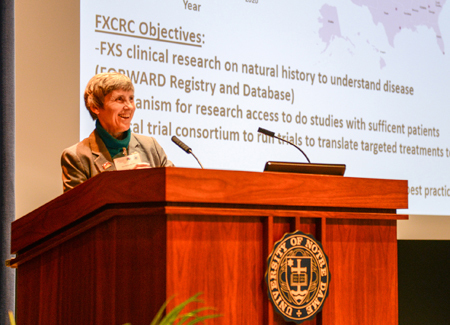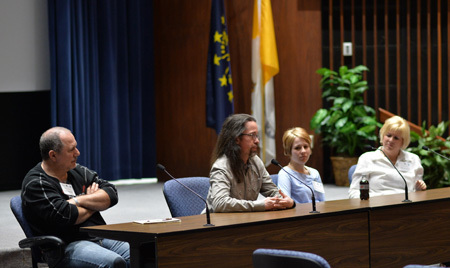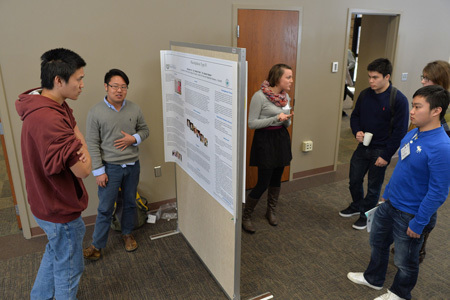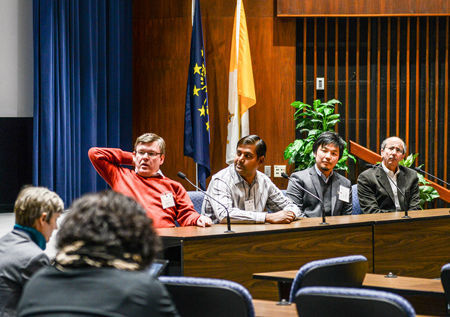
Elizabeth Berry-Kravis '79, M.D., Ph.D.
Photo by: Bluekrishna Photography
The Center for Rare and Neglected Diseases (CRND) and the Rare Health Exchange (RHE) celebrated World Rare Disease Day on Saturday, Feb. 15 at the Notre Dame Conference Center. World Rare Disease Day is a global event that was first launched in 2008 to raise awareness among the general public and decision-makers about rare diseases and their impact on patients’ lives.
“We began celebrating rare disease day in 2009,” said Shahir Rizk, Director of External Programs for the CRND and Research Assistant Professor of Biological Sciences. “Last year, we tried out the public forum format and found it to be well received. It gives Notre Dame a chance to be engaged with the local community and to provide a forum for rare disease patients and families to interact with researchers, physicians and students.”
The day-long symposium was dedicated in memory of Tylor White-Richardson and Riley Smith, two patients who recently passed away from Niemann-Pick Type C (NPC) disease, a rare cholesterol storage disorder that affects approximately one in 100,000 people.
Elizabeth Berry-Kravis ’79, M.D., Ph.D., professor of pediatrics, neurology, and biochemistry at Rush University Medical Center in Chicago, participated in a panel about experimental drug treatments. She works with families whose children have NPC. Berry-Kravis explained that for many years, the only option for NPC treatment was to provide supportive care to help alleviate the symptoms, but “thanks to the Parseghian Foundation, there has been a significant increase in NPC research in the last 20 years.”
Berry-Kravis was able to get approval from the FDA through the Investigative New Drug (IND) Program to provide an experimental treatment for her patients using cyclodextrin, a small molecule therapy, which is also being tested at other clinical sites. “These diseases have ups and downs so you need to look at trends over time, but we are seeing early subtle, but promising results,” said Berry-Kravis.

Rare disease patient & family forum
Photo by: Matt Cashore/Notre Dame
Several attendees shared their experiences in open forum focused on living with rare diseases. Coley Mrozcek shared his experience with X-Linked Hypophosphatemia (XLH), a disease that disrupts the assimilation of vitamin D and phosphorus in his body and causes bone malformation. His mother, three siblings, and daughter all have XLH. “It is different being a patient of XLH, and having a child with it,” Mrozcek explained. “My daughter is 12 years old. She has difficulty running because of the way her legs have formed and other children are starting to notice. A better form of treatment is a priority for me and the way the research is going is encouraging for me as a parent.”
Cindy Riemersma came with her 21 year old daughter, Jyl, who was diagnosed with Glucose Transporter Deficiency Syndrome at the age of four. Jyl was only the 15th person in the world diagnosed with the syndrome. There are now more than 250 people diagnosed worldwide, indicating the importance of diagnosis.
A major theme that emerged from the discussion was that all of the patients and families present had taken ownership of their situations and worked tirelessly to get the answers and treatments they needed because information and resources are much more limited with rare diseases. Muriel Finkel of the Amylodosis Support Groups Inc., a member of the National Organization of Rare Diseases, stressed the importance of service organizations that cater to specific rare diseases. These organizations can help connect patients to resources, such as treatment options, counseling and other patient families.

Student poster presentations
Photo by: Matt Cashore
The second half of the day included a poster session and research presentations from Notre Dame students and faculty. ESTEEM students Bianca Fox and Yuan Gao described the RHE program, a collaboration of students and patient families working together to develop a database to help rare disease patients and their caregivers. Over the last five years, many families including the White-Richardson and Smith families have visited with Notre Dame students and faculty to help develop the RHE.
Four Notre Dame researchers discussed their work on various lysosomal storage diseases. Shaun Lee, Assistant Professor of Biological Sciences, and Tony Serianni, Professor of Chemistry and Biochemistry, described their research collaboration on Sanfilippo syndrome, a disease which prohibits an enzyme from properly breaking down complex sugars. In addition to developing new therapies, their work also helps predict whether a patient will respond to two major types of treatments that are currently being developed for this disease. Md Suhail Alam, a postdoctoral research associate in Biological Sciences who works with Kasturi Haldar, the Rev. Julius Nieuwland, C.S.C. Professor of Biological Sciences and James C. Parsons and Carrie Ann Quinn Director of the Center for Rare and Neglected Diseases, reported on the first plasma biomarker for neurodegeneration that can be used to monitor whether NPC patients on a therapy are improving in brain disease. Olaf Wiest, professor of chemistry and biochemistry, discussed how he uses powerful computers to find FDA-approved drugs that can be repurposed to treat rare diseases like NPC.

Lysosomal storage disease presentation
Photo by: Bluekrishna Photography
The second research session focused on rare cancers, which are often difficult to diagnose and have a poor prognosis. Başar Bilgiçer, assistant professor of chemical & biomolecular engineering and concurrent assistant professor of chemistry and biochemistry, described his work on developing nanoparticles to target multiple myeloma and Laurie Littlepage, Campbell Family Assistant Professor of Cancer Research, explained how her work is trying to compare the biology of a rare breast cancer that affects Kenyan women with cancers found in North America. In addition, Cassandra Buchheit, a graduate student in biological sciences who works with Zachary Schafer, Coleman Assistant Professor of Cancer Biology, spoke about her work with a rare inflammatory breast cancer that is often misdiagnosed as an infection.
Mike Hamerlik, CEO of WPS Health Insurance joined one of the patient family representatives to explain how new health insurance laws will impact rare disease patients. This panel was particularly informative to the families who have traditionally had few options when it comes to health insurance.
To conclude the seminar, the group completed a rare disease quiz prepared by the newly minted RareND club, which reminded the audience how much still needs to be done to raise awareness for rare diseases. They also sang a new version of the Notre Dame fight song to rally the fight against rare diseases.
Originally published by at science.nd.edu on February 24, 2014.